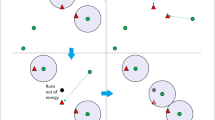Abstract
This paper proposes a novel approach to clustering the interests of mobile users, increasing the lifetime of interest groups, and increasing the throughput in mobile user-to-mobile user environments for mobile IPTV (MOTV) societies. This paper develops an interest ontology of cellular automata (CA) clustering using the zone of interest (ZOI) for mobicast communications in mobile ad hoc network (MANET) environments. The key to the proposed method is to integrate CA clustering with the ontology of users’ interests. This paper proposes that both an interest profile (ontology) of users and information about mobile devices can help form a group of MANET-related interests. The current study evaluates the performance of the approach by conducting computer simulations. Simulation results reveal the strengths of the proposed CA-clustering algorithm in terms of increased group lifetime and increased ZOI throughput for MANETs.














Similar content being viewed by others
References
Agilent Technologies. (2005). Ensure IPTV quality of experience, White Paper.
Begen, A. C., Glazebrook, N., & Ver Steeg W. (2009). A unified approach for repairing packet loss and accelerating channel changes in multicast IPTV. In Consumer communications and networking conference, CCNC 2009. 6th IEEE, 10–13, Jan. 2009, pp. 1–6, Las Vegas, NV.
Bi, Y., Liu, K.H., Shen, X., Zhao, H. (2008). A multi-channel token ring protocol for inter-vehicle communications, Global telecommunications conference. IEEE GLOBECOM 2008. (pp. 1–5). New Orleans, LO: IEEE.
Chen, H., Finin, T., Joshi, A., Kagal, L., Perich, F., & Chakraborty, D. (2004). Intelligent agents meet the semantic web in smart spaces. IEEE Internet Computing, 8(6), 69–79.
Cho, C., Han, I., Jun, Y., & Lee, H. (2004). Improvement of channel zapping time in IPTV services using the adjacent groups join-leave method, In Advanced communication technology, 9–11. The 6th International Conference, (Volume 2, pp. 971–975.) Phoenix Park: Korea.
Committee SCC32 (2006) IEEE P1609.4 Standard for wireless access in vehicular environments (WAVE): Multi-channel operation, draft standard, IEEE Intelligent Transportation Systems Council.
Etoh, M., & Yoshimura, T. (Aug. 2005). Wireless video applications in 3G and beyond. IEEE Wireless Communication, 12(4), 66–72.
FCC Report and Order: FCC-03-324 (2004) http://hraunfoss.fcc.gov/edocspublic/attachmatch/FCC-03-324A1.pdf.
Fitzek, F., & Reisslein, M. (Oct. 2001). A prefetching protocol for continuous media streaming in wireless environments. IEEE Journal on Selected Areas in Communication, 19(10), 2015–2028.
Gardner, M. (1972). The fantastic combinations of John Conway’s new solitaire game Life. Scientific American, 233, 120–123.
Jenkac, H., Stockhammer, T., & Xu, W. (2006). Asynchronous and reliable on-demand media broadcast. IEEE Network, 20(2), 14–20.
Joo, H., Song, H., Lee, D. B., & Lee, I. (2008). An effective IPTV channel control algorithm considering channel zapping time and network utilization. IEEE Transactions on Broadcasting, 54(2), 208.
Kim, J., Hahm, J. H., Kim, Y. S., & Choi, J. K. (Feb. 2006). NGN architecture for IPTV service without effect on conversational services. International Conference on Advanced Communication Technology, 1, 465–469.
Kyriakidou, A., Karelos, N., & Delis, A. (2005). Video-streaming for fast moving users in 3G mobile networks. Proceedings of Fourth ACM International Workshop data engineering for wireless and mobile access, pp. 65–72.
Leung, M.-F., & Chan, S.-H. G. (2007). Broadcast-based peer-to-peer collaborative video streaming among mobiles. IEEE Transactions on Broadcasting, 53(1), 350–361.
Liu, Y. (2009). Modelling urban development with grographical information systems and cellular automata. Boca Raton: CRC Press.
Liu, D., Stojmenovic, I., Jia, X. (2006). A scalable quorum-based location service in ad hoc and sensor networks. In Proceedings in IEEE MASS, pp. 489–492.
Mamei, M., Roli, A., & Zambonelli, F. (2005). Emergence and control of macro-spatial structures in perturbed cellular automata, and implications for pervasive computing systems. IEEE Transactions on Systems, Man and Cybernetics, Part A: Systems and Humanps, 35(3), 337–348.
Missoum, S., Gürdal, Z., & Setoodeh, S. (2005). Study of a new local update scheme for cellular automata in structural design. Structural and multidisciplinary optimization, 29(2), 103. doi:10.1007/s00158-004-0464-2.
Park, W., Choi, C., Kim, D., Jeong, Y., & Park K. (2005). IPTV-aware multiservice home gateway based on FTTH access network, In International Symposium on consumer electronics, pp. 285–290.
Protégé Home Page, http://protege.stanford.edu/.
Sharpe, R., Heiles, J., Liu, H., Deschanel, M., Wu, Y., Maisonneuve, J., et al. (2009). An overview of IPTV standards development. IEEE Transactions on Broadcasting, 55(2), 315–328.
Shirazi, H., Cosmas, J., & Cutts, D. (2010). A cooperative cellular and broadcast conditional access system for pay-TV systems. IEEE Transactions on Broadcasting, 56(1), 44–57.
Task Group p. (2006). IEEE P802.11p: Wireless access in vehicular environments (WAVE), draft standard ed., IEEE Computer Society.
Tekla, S. (1996). The trial and travails of interactive TV. IEEE Spectrum, 4, 22–28.
Thompson, G., & Chen, Y.-F. R. (2009). IPTV: Reinventing television in the Internet age. IEEE Internet Computing, 13(3), 11–14.
Wolfram, S. (1984). Cellular automata as models of complexity. Nature., 311, 419–424.
Woo, S., & Singh, S. (2001). Scalable routing protocol for ad hoc networks. Wireless Networks, 7, 513–529.
Xue, G.-T., Jia, Z.Q., You, J.Y., & Li, M.L. (2004). Group mobility model in mobile peer-to-peer media streaming system, Proceedings 2004 IEEE International Conference on Services Computing (pp. 527–530).
Younis, O., & Fahmy, S. (2004). HEED: A hybrid, energy-efficient, distributed clustering approach for ad hoc sensor networks. IEEE Transactions on Mobile Computing, 3(4), 366–379.
Zang, Y.P., Stibor, L., Walke, B., Reumerman, H. J., & Barroso A. (2007). Towards broadband vehicular ad-hoc networks: The vehicular mesh network (VMESH) MAC Protocol, In Proceedings of IEEE WCNC’07, March 11–15, (pp. 417–422).
Zhu, Y., Liu, W., Dong, L., Zeng, W., and Yu H. (2009). High performance adaptive video services based on bitstream switching for IPTV systems, In IEEE consumer communications and networking conference.
Author information
Authors and Affiliations
Corresponding author
Rights and permissions
About this article
Cite this article
Chou, CL., Horng, GJ. Using Cellular Automata to Form an MOTV Society in Mobile Ad-hoc Networks. Wireless Pers Commun 80, 591–609 (2015). https://doi.org/10.1007/s11277-014-2030-6
Published:
Issue Date:
DOI: https://doi.org/10.1007/s11277-014-2030-6




